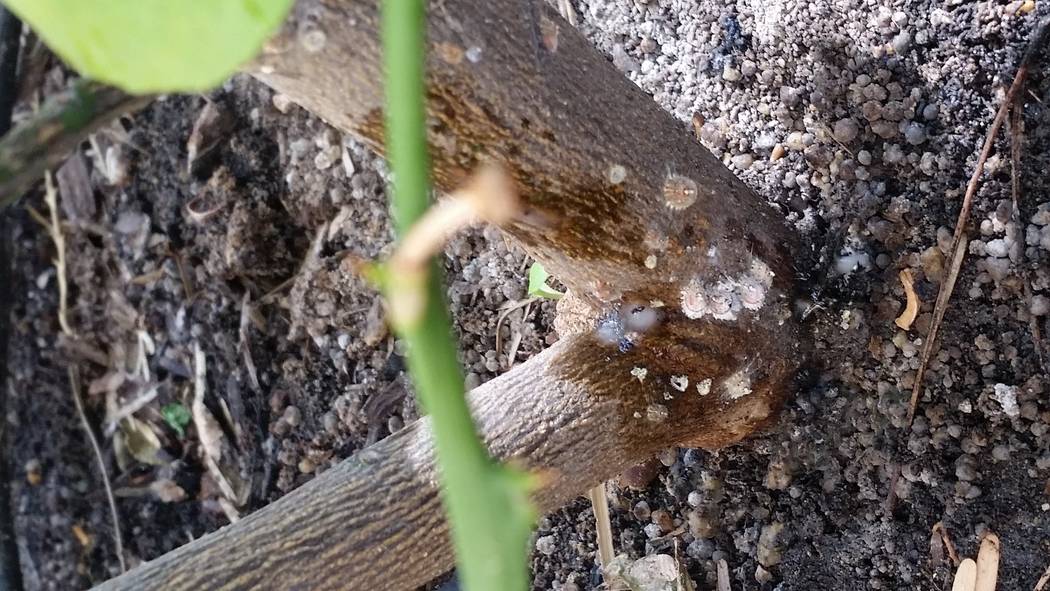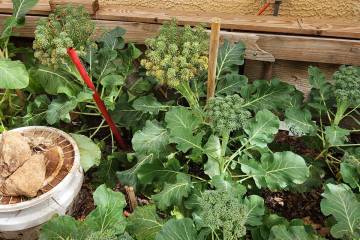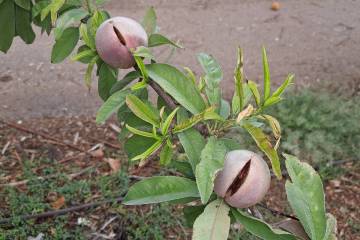Cottony cushion scale produces sap on lemon tree
Q: Last year, we bought a Meyer lemon and planted it in a large pot. We got more than 30 lemons off this little tree. I noticed a lot of sap near the base of the tree, then a bunch of furry little things on the trunk and some branches. They scrape off easily. I’m guessing they are the cause of the sap.
A: You are right. This is cottony cushion scale, an insect, on your lemon tree. Those little furry things are homes to the scale insect. They live under those furry things, where they are protected from pesticides and predators.
Once in a while they come out and build a larger, furry home or find a mate. When they do, this is called their “crawler” stage, when they are most vulnerable to pesticides and predators.
What’s interesting are the ants that you didn’t mention. These small-scale insects feed on the sugary sap inside the tree. While feeding on this sugary sap, a sugary concoction comes out the other end that some ants love.
These ants move these insects in the spring to new growth, where feeding is a lot easier than at the tough, woody base of the tree. In these new locations, ants herd them like cattle and protect them from marauders.
From your photo, it doesn’t look like you have very many on this tree yet. Take some alcohol and a cotton swab and dab them off. If there were lots of them, you could spray horticultural oil several times during the year, particularly during tree growth periods.
These oils suffocate the crawlers and keep them from spreading, while the older ones eventually die off. Apply these oils three or four times during the year at times when temperatures are cool. By the way, it also helps a lot to control any ants in the area.
Q: Our cape honeysuckle has done well, even bloomed during the past winters. But this time of year it always stops blooming. Is there something I should be doing or not doing to keep it flowering through the summer?
A: Cape honeysuckle is from South Africa, below the equator, so its bloom time is the opposite of ours; it blooms in the winter and not during the summer. Another plant from South Africa, African sumac, does the same thing.
Cape honeysuckle is a great plant for the dry desert, because it is not as invasive here as it can be in wet climates. The only drawback: It is winter tender at temperatures around 25 degrees F.
Watch for freezing damage during particularly cold winters or in cold landscape microclimates. Much like bougainvillea, if the base is protected with mulch during the winter, it will grow back again from the protected base.
Q: I have a rose bush that did well for years, but now it only produces small white roses. What happened?
A: The top of your rose bush died, but the rootstock survived. Two different plants are combined into one plant through a propagation technique called budding. The top of the plant is desired for its beautiful flowers. The rootstock is selected for a variety of reasons but performs better in soils than the top of the plant would if it had roots.
All rose bushes available commercially are grown on rootstocks. These rootstocks are also roses, but their flowers are a different color and size than the rose you selected. In your particular case, the rootstock was perhaps Rosa odorata, a rose that produces small white flowers.
If you don’t like the plant, then remove it and replace it with a variety that grows well in our hot, desert climate. The website of Weeks Roses (weeksroses.com) publishes a list of roses by flower color and rose type that perform well in the hot desert. Or talk to some neighbors who love roses and find out what they planted.
Be careful when pruning roses. Prune them in January, but do not cut them back too short. Pruning roses short can cause the rootstock to grow vigorously and send up suckers that could dominate an overly pruned rose bush. And remove all suckers coming from the rootstock.
I noticed in your photo that your roses were surrounded by rock mulch. Roses do not like rock mulch. Get rid of the rock and lay down some compost. Cover the compost with 3 inches of wood chip mulch instead. Your roses will be much happier.
Q: I have a 5-foot yucca tree that I cannot get to be disease-free after two years of trying. I have tried several insecticides and fungicides. I hope you can identify the problem from the picture.
A: The yucca leaves are scorching or turning brownish white in the middle at the bend where the leaf is curving down. This is not a problem you can correct by treating with insecticides or fungicides.
This is an ornamental yucca called Spanish dagger with flat leaves coming from the trunk and curving slightly downward. You would think that yuccas would be a plant not requiring much care in the Mojave Desert. Well, this one does. It is native to coastal Carolinas, Georgia, Florida and Alabama.
This is a cultural management problem. It should be addressed by transplanting it to a new, protected location and adding amendments to the soil at the time of planting. Water it more like a palm tree than a cactus.
Although classified as a disease, it is not caused by anything biological, so pesticides won’t do any good. This problem is more correctly classified as leaf scorch. It is a soil/planting location/water management problem.
Don’t plant this yucca as you would yuccas that grow easily in desert environments. This particular yucca prefers protection from the hot, late afternoon sun and grows in richer soils — soils amended with compost at the time of planting and not surrounded by rock mulch.
What to do now? Move it to a new location that gives it protection from direct, late-afternoon sun. If it is surrounded by rock mulch, get rid of it. With a post hole digger or soil auger, make several vertical chimneys in the soil about 2 feet deep and 18 inches from the trunk. Pack these vertical chimneys with compost and then soak them with water.
Water this plant like a normal landscape plant with good drainage, and make sure it is watered on four different sides with enough water each time to percolate 18 inches deep.
Q: From your past articles, I thought my vitex or chaste tree was not going to give me problems if planted near a wall. I was shocked this spring when I saw a 3-inch-diameter root from our chaste tree over 15 feet away heading toward a wall. I had it removed and the root cut out. You mentioned that cottonwood trees can resprout from their roots after the tree is cut down. Can I expect the same situation with my chaste tree?
A: Probably not. To my knowledge, vitex roots will not grow back from the roots if the top of the tree is removed. It will sucker from its base if you do not remove the entire tree stump, including a few inches below the soil surface. Removal is done by hand or using a stump grinder.
Normally, this is a small tree that has few problems. It has few roots that grow on the soil surface, so reading your email is a bit of a surprise.
This tree is, however, notorious for invasive roots that grow into septic tanks and sewer lines when there is an opportunity. As with any tree, never plant it on top of or close to a leach field.
I am guessing this tree root found something it liked in the direction of the wall. Like most plants, once they find a rich deposit of water and nutrients, roots grow vigorously in that area and can enlarge quickly.
Roots do not grow into an area and explore it. They are not adventurers. They are opportunists.
Roots grow most vigorously where there is water, air and nutrients. Plants such as vitex, with few surface roots, grow near soil surfaces because they have to, not because they want to.
Apply water and fertilizers in areas where you want roots to grow. Discourage root growth by not applying water and fertilizer toward problem areas.
Bob Morris is a horticulture expert and professor emeritus at the University of Nevada, Las Vegas. Visit his blog at xtremehorticulture.blogspot.com. Send questions to Extremehort@aol.com.























